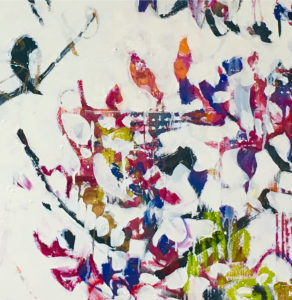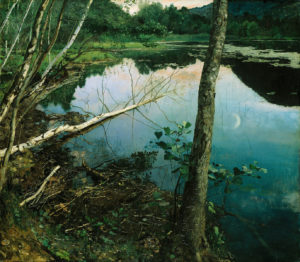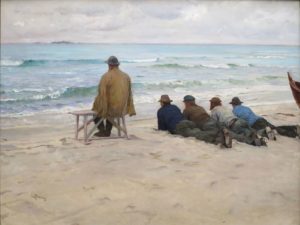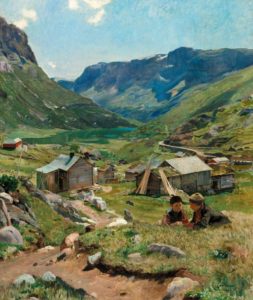Dear Artist,
During the last while I’ve been giving my two bits worth to several would-be painters. These folks are young, well educated and talented. They want to talk about the business of making art, the possibility of going to art school, their future in art. They also check my modest brain for what I might think galleries want, price points, popular sizes, that sort of thing.
While this is all very nice, I’ve glazed over a few times, and frankly told one of them to paint a hundred paintings and give me a call when she does. There was a significant silence on the other end of the phone — as if it was just around the corner that I might coach creativity into her. “Think of yourself as a factory,” I said. That was the end of that call.
Not many of us can be convinced that working in a factory is a lot of laughs. Being a factory may be even worse. But there’s something to be said for building one and getting into it.
Artist-wannabees need to find a physical place to be. For artists who think big and lofty, an unused loft in a rust-belt town might be the choice. But a factory can also be in a corner under basement stairs, or an easel at the bottom of a garden. Factory is a mental thing.
An art factory is a place where unmarked supports enter on one side, become caressed with the physical manifestation of human imagination, and are subsequently pushed out the other side. Whether these modified supports are commercially destined or not, it’s a process that needs to take place.
When the factory gets the steam up and things begin to happen, the worker becomes hooked. Also, as skills are learned, techniques defined and directions found, the place begins to look like a perpetual motion machine.
Theoretical folks don’t always understand that the factory itself turns its operator back into a student. The factory becomes a school. If you like the idea of do-it-yourself learning, and you are curious about what you might be able to do, a little private factory is one fine institution. If your factory starts small and gets productive, you’ll need a bigger factory. “Room service? Send up a larger room.” (Groucho Marx)
Best regards,
Robert
PS: “You need a room with no view so imagination can meet memory in the dark.” (Annie Dillard)
Esoterica: I often ask folks how much they like working on their own. Funnily, almost everyone says they love the idea. But when push comes to shove, many can’t go long without phoning somebody, or hanging out. It’s a distracting world. It may also have something to do with the interactive way kids are raised these days. Unless aspiring artists are particularly introverted or antisocial, it can be a struggle to achieve the full factory focus that creates proficiency. For some folks it only comes with maturity.
This letter was originally published as “Build the factory” on September 9, 2008.
“You can’t fake quality any more than you can fake a good meal.” (William S. Burroughs)
Featured Workshop
 Join Ellie Harold for “Intuitive Painting: Permission to Paint Expressively,” designed especially for mature women artists of all skill levels who wish to explore this medium for soulful exploration. The retreat provides attractive accommodations (your own room!) along with lightly structured activities for centering, relaxation and low stress art-making. You’ll have plenty of free time to muse, paint, write and reflect while enjoying the colors, textures and flavors of San Miguel. This Retreat has the potential to transform not only your art but your life! You’ll return home with a specific art “care plan” to assure support for further creating. Details at www.EllieHarold.com.
Join Ellie Harold for “Intuitive Painting: Permission to Paint Expressively,” designed especially for mature women artists of all skill levels who wish to explore this medium for soulful exploration. The retreat provides attractive accommodations (your own room!) along with lightly structured activities for centering, relaxation and low stress art-making. You’ll have plenty of free time to muse, paint, write and reflect while enjoying the colors, textures and flavors of San Miguel. This Retreat has the potential to transform not only your art but your life! You’ll return home with a specific art “care plan” to assure support for further creating. Details at www.EllieHarold.com.
Featured Artist
I am a landscape painter exposing the mystery in an ordinary day.








22 Comments
Another valuable share….
Great advice!
This letter is particularly significant today because the factory approach is exactly the mind set I got in to with the prospect of needing 18 to 20 paintings for a solo show.
The intention was to start 7 pieces at a time so they would be more spontaneous and hopefully reveal more of my soul. I’ll know when I hang the show, one week from Monday, if I succeeded but it’s been a scary proposition. I have 5 panels still evolving.
Re: Esoterica : Wow, that resonates with me – I like to paint in my garage, with the doors open because of the fumes, and without fail, my neighbor who I like a lot, always comes over to chat which drives me completely crazy. They are also a chain-smoker, and I do not smoke so that’s extra fun. One day I want to have a studio somewhere deep in the woods, away from civilization, so I can focus. Thank you for so much insight you provide! Keeps me going! :)
Ummmm — it is entirely acceptable to request that the person not bring their cancer sticks into your space, and I say that as a former smoker. It is also entirely permissible to sincerely tell someone that as much as you enjoy their company, you are in fact WORKING and effectively on the clock. You might even start a little log book with your start and stop times as further proof. This can be followed by an offer to get together at some time in the evening or on a day off. If the individual in question is offended by this, their company is not worth it.
Another interesting read- thank you. I know of a successful children’s book illustrator who told himself he wouldn’t judge his ability to paint until he had painted one hundred paintings; this propelled him to evolve. and grow.
A “factory” sounds like too much work to most people, it seems!
Go and paint acres of canvas, I was told by a mentor. And I would add have your own place where you can see your work with your paints and brushes ready so it’s no effort to pick them up.
I read this edition saying yes yes yes out loud all the way through! I love the idea of calling it a factory – it really strips of the preciousness of the process and lets it be what it is, hard work demanding real focus and concentration, constant courage and determination. A factory after all is just a place where things get made. Thanks!
After years of teaching art with little time to paint, I did exactly this and painted 107 11 x 14 paintings in about 18 months. It turned my mind back on.
fabulous letter! i also appreciate the camaraderie of knowing others are out there in their factories — working, perfecting them, re-routing old methods of assembly, finding new rooms. thank you!
Me too! to all of the above. An artist’s life in films and books is too often depicted as a romantic, mysterious life where
one calls their own shots. Not so, and would be artists should be told the message in Robert’s letter….and art schools
should better prepare artists for the reality of the life ahead. I have few regrets, but had I known a path I would not have wasted time by going down so many “wrong roads”. At the age of 80 I look back and wish I had received more advice on how to proceed AFTER art school.
I so needed this. I realized I really couldn’t take one more class until I figured out what I’ve learned along the way so far. No more new techniques or special palettes or tricks of color and shadow and light. I just needed to do it! I am bowled over by the realization of the commitment but that is the road I do want to take. Thanks for sharing. I find your newsletters invaluable and they are my Tuesday and Friday mornings first reads.
Terri Carlson
Port Townsend, WA
Love this letter from Robert. So true, in my experience. Feel like a lot of artists I meet don’t put in the regular hard work it takes to be good. They paint sporadically and infrequently then blame their lack of “talent” or the art glitterati or their lack of prowess at social media when they don’t succeed. Particularly enjoyed that he basically advised the young artist to stop putting the cart before the horse. Not to mention that painting what you think others will like as opposed to what you personally care about … your lack of passion for the subject always shows up on the canvas. It does really help to have a dedicated space for your “factory,” even if it is a humble one. Anything to encourage more creating and less procrastinating.
Truth. As a ceramic artist, I know how well the factory mental, (and physical), model works. My medium is considered industrial, a surprise to so many people! Make sense that painting can benefit from the same treatment.
My goodness, 20+ years ago, I was one of those new “artists” that Robert told – in person – to do 100 paintings and then come back to see him.
I’d shown him photos of my first eight paintings; asked about how you know your style is emerging. A year later, I’d completed 100+ works – they were, no holds barred – “all over the place” different from each other. None of them ended up how I’d planned for them to be, often starting with the first stroke.
I stretched and stapled large canvases to the basement wall; hung the finished ones on rods in the laundry room; used left-over paint on smaller canvases so as not to waste – some of them ending up my favourites; and saw quite quickly a leaning toward large and abstract work emerging. The learning curve was exciting and worked to restore some balance in life. (Intense care needs for my eldest continues today).
I never did get the opportunity to revisit my 100+ works with Robert, however, I am guessing that was not his aim. Doing 100 works invites you on a journey of self exploration, new learning, evaluation, invention, innovation, discovery joy and, in my case, also relief. Exploration is likely personalized with each painter.
Two years after Robert’s “assignment” over 100 paintings solo-debuted in a floatplane hangar at the Vancouver airport. Renowned painter Tony Onli showed up. There was TV coverage. High school Art students chaperoned people through the exhibition. The majority of works sold. I was completely shocked that ANY sold.
I am grateful to Robert for his fail-proof, 100 paintings strategy. Those 100 paintings allowed me the freedom to finally start exploring a part of self I’d already known about when I was four years old. Now onto the next 100 – another “period” of art.
Keep well.
Cindy
How this piece rings true! Like many becoming artists, I love the idea of 10,000 hours of work, and began this journey while having a full time career as a journalist. Surprise! the news reporting dried up in the Great Recession, and I set out in fits and starts to become a full time artist. Today I can look back and laugh at some of those early, earnest attempts (and some of them have landed in the garbage can), but I am successful and have work in two galleries and have sold to people all over the country and the world. Work was worth it, and it means more to me today than ever.
As our feature artist here today, I thought I should say something though I wholeheartedly think Robert has captured the situation nicely! Depending on the size, I generally paint and release between 30-40 paintings a year. There is a rhythm to the process and an intention that is set that keeps me either painting, gathering references for paintings, painting edges, putting on hanging wires, uploading inventory in the online gallery posting on social media about paintings, writing a newsletter to publish every 2nd Friday about paintings, researching my next locations or subject focus for paintings, showing paintings, selling paintings or following up with potential art collectors about paintings. Absolutely everything else from getting dress, brushing my teeth, doctors appointments, visiting family or friends is fit in as a secondary activity after completing what needs to be done for painting. I have no pets, gardens or house plants, (except a small orchid that I just received for my birthday – not sure it will last long). My social life is a once a week zoom call with a painting group. My husband gets my best undivided attention when he asked me about a painting or when it is too dark or I am too tired to paint and so on. Thankfully, I am a landscape painter so this means lots of time outdoors on hiking trails exploring and gathering references. It is a good life but it currently has a rather singular focus with other thoughts and activities supporting the primary impetus to paint. I make no apologies for my approach. I am working. For many years now these painting practices have provide the structure and results that I need in order to accomplish what I set out to do. Keep going everyone and some great comments today!
A dear friend decided to follow the Chinese adage, “To learn to draw you must draw the 10,000 things,” filling little handmade books and numbering the drawings. She completed it in about 4 years, and we had a party in my studio to celebrate. Inspired by her work, I began drawing more regularly during the pandemic. I’m not drawing ‘things’ but I’m drawing compositions of lots of little things and not numbering them. 10,000? Maybe. But oh my, are they better. Now to commit to filling a gallery. Did it when I got my MFA , loved every minute, just gotta keep following the next thread.
I am 89 years old and paint everyday. I am a happier painter today than I was when doing the galleries, workshops, running, running running. I do no marketing, social columns, and all that hopeful artists are suppose to do. And I make no apologies for it. *I am a much more relaxed and happier painter….and a happier person. My paintings are going to push me out the front door of my gallery/studio but that is okay because I am happy, happy. Now I know that many artists strive to make money, but a change needs to take place in their thinking….and decide what is important in life AND, DON’T WAIT UNTIL YOU ARE IN YOUR EIGHTIES. Enjoy and have fun with what you are doing NOW and you will be happier and more relaxed NOW. My prayers to all of you.
Great advice, Gerri! I’m taking it!!
I am 83 and agree with Gerri. No pressure, just painting. I paint with mixed media and collage. I live on Maui and Paint outdoors, unless it is raining. I am fortunate to have done the Art Fairs and galleries over the years, but with covid the past year and a half I have been pretty much in solitude. And that is ok.
Dear Sara,
Always enjoy and often inspired by the letters in the Genn series. This on prompted the following comment.
Not thinking of myself as a factory, I a seasoned painter challenged myself to do a 100 painting series. Begun in September and completed in January in the year of the Pandemic, I was inspired to paint 100 4×6 inch oil on paper, Woodland Scenes ( en plein air and studio).
Focus upon seasonal change brought much detail to concentrate on enabling me to observe color, shapes and forms honing my skills as I applied paint to ground.
The 100 Woodland Scenes are currently being displayed at the Wayne County Arts Alliance Main Street Gallery in Honesdale, PA.